
The Solar-Terrestrial Centre of Excellence (STCE) is a collaborative network of the Belgian Institute for Space Aeronomy, the Royal Observatory of Belgium and the Royal Meteorological Institute of Belgium.
 |
Published by the STCE - this issue : 1 Nov 2013. The Solar-Terrestrial Centre of Excellence (STCE) is a collaborative network of the Belgian Institute for Space Aeronomy, the Royal Observatory of Belgium and the Royal Meteorological Institute of Belgium. |
| Archive of the newsletters | Subscribe to this newsletter by mail |
No, Beta-Gamma-Delta (BGD) is not about some high-school prom reunion, but one of the possible magnetic classifications of a sunspot group. These classifications play a major role in determining whether or not a sunspot group is up to significant flare activity.
Sunspots have their origin in magnetic flux tubes breaking through the solar surface. The magnetic disturbances create local cooling (compared to the surroundings), hence sunspots are visible as dark specks on the solar surface. Seen in a magnetogram, spots where the magnetic field (tube) comes out of the surface are often displayed as blue or white. Spots where the field returns into the Sun are usually depicted in red or black.
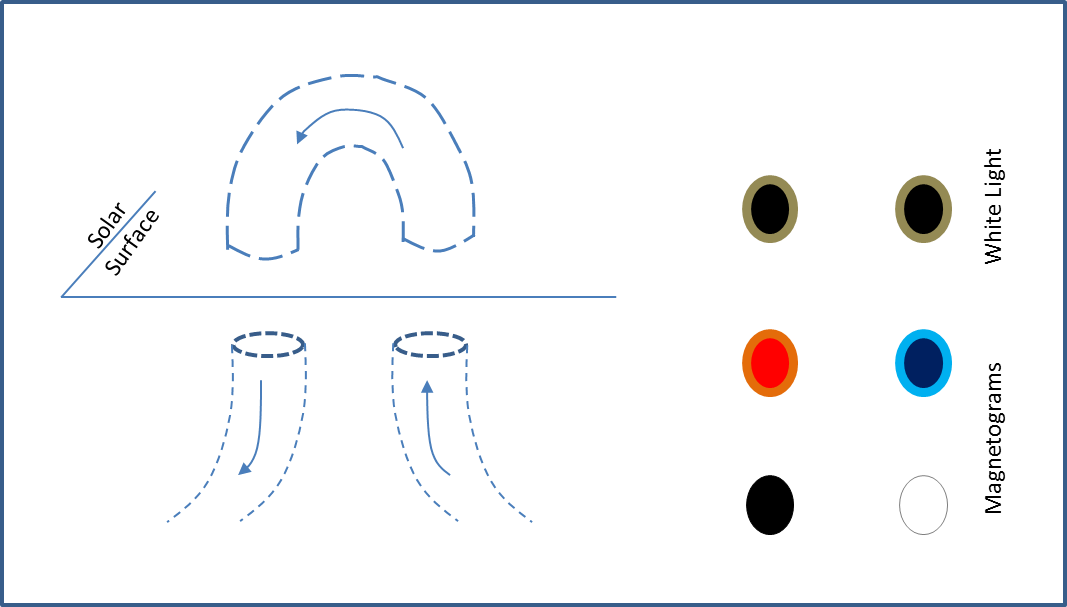
Solar flares on the other hand find their origin in the magnetic reconnection between magnetic fields of opposite polarity that are very close together. The latter specification is required, because otherwise every bipolar sunspot group would produce many and strong flares, which is not what we observe!
Thus, normal sunspot groups are bipolar and have magnetic polarities that can easily be distinguished (see sketch above right). However, some groups may become quite complex with many sunspots of opposite polarities. At some point, it may become impossible to distinguish it as a bipolar group. When that happens, it gets the "Gamma" classification. This kind of group is quite rare, and usually we get a Beta-Gamma (BG) classification: There's an indication of bipolarity, but no continuous line can be drawn separating spots of opposite magnetic polarities.
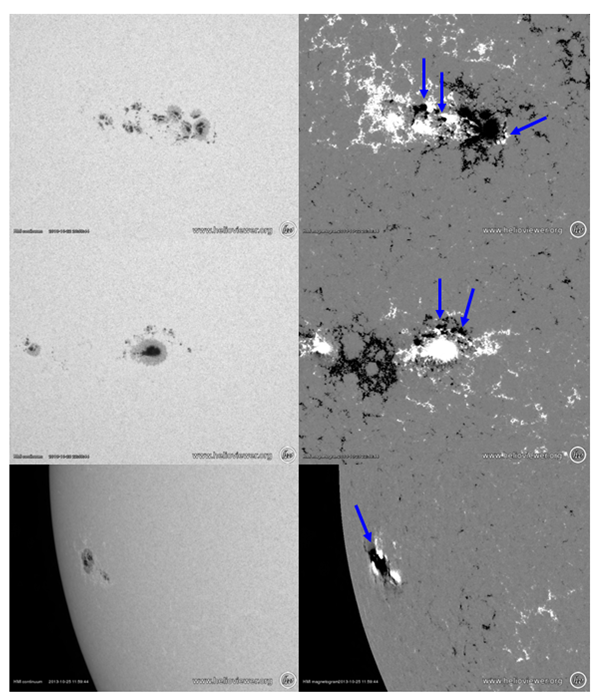
The specification "Delta" is given to sunspot groups that contain spots of opposite polarity within the same penumbra and within 2.5 degrees from each other. A few examples have been indicated by blue arrows on the magnetograms of last week's 3 important flaring regions: NOAA 1875 (top), NOAA 1877 (middle), and NOAA 1882 (bottom). NOAA 1875 and 1882 had a BGD classification for most of the time, with the Delta's indicating an increased likelihood on magnetic reconnection between the opposite polarity sunspots, and thus on (strong) solar flares. NOAA 1877 was mostly BG, with an occasional delta.

True to the predictions, these sunspot groups produced several strong flares. A movie with the main events can be found at http://www.youtube.com/watch?v=xhx0JlaBXuQ
During the evening hours of 22 October, NOAA 1875 produced a M4 solar flare ("medium class"). The eruption showed some interesting features in H-alpha (chromosphere), such as the ejection of dark ("cold" and dense) material which are probably "surges"; the jury is still out on this one. There's also a shock wave visible precipitating through the Sun's lower atmosphere. This is called a "Moreton wave" and can be seen as a whitish line moving fast (500 km/s) to the bottom right of NOAA 1875.
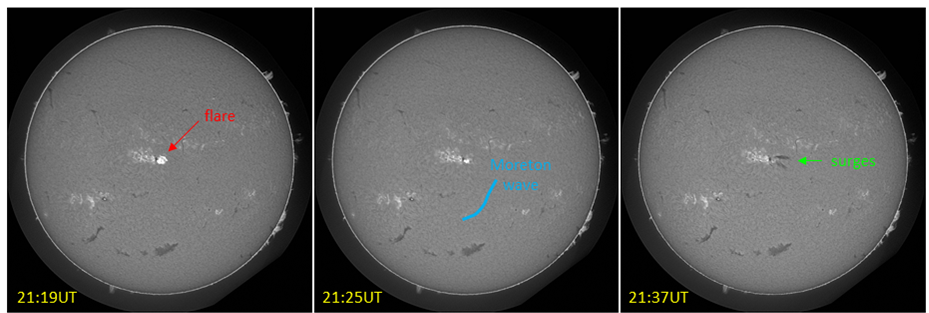
On 24 October, a M9 flare took place in NOAA 1877. Aside the very nice eruption, one could also observe magnetic interactions with NOAA 1879 (to the east; "left" of the flaring region) and material movement across the solar equator towards the trailing part of NOAA 1875.
On 25 October, NOAA 1882 claimed all attention by unleashing 2 X-class solar flares in a single day. These flares belong in the eXtreme class of solar eruptions, and -so far- the ongoing solar cycle had produced only 19 of these strong flares (see this STCE Newsitem at http://stce.be/news/198/welcome.html for an overview).
The X1.7 flare peaked at 08:01UT in the trailing part of NOAA 1882, where a strong delta was present. Interestingly, almost immediately following the flare, a filament erupted many 100.000's km further away on the southern hemisphere. This was similar to an earlier eruption in NOAA 1882 that day, when a medium flare around 03:00UT coincided with an ongoing filament eruption on the northern hemisphere. Since the "global" solar eruption event in August 2010, scientists are well aware that magnetic connections between far away regions can exist on the Sun, which can lead to a domino effect of flares and filament eruptions (see this STCE Newsitem at http://stce.be/news/x129x/welcome.html ).

The X2.1 flare peaked at 15:03UT in the same area as the X1.7 event. It produced an EIT wave and was a typical example of a solar flare: a reconnecting magnetic loop with material being ejected, the bright flare itself, and the post-flare coronal loops (see image underneath). Not always are all these features so well visible, courtesy SDO!

All this extra x-ray radiation energized the ionosphere, a layer in the Earth's atmosphere that influences radio propagation to distant places on the Earth. Meteor observers using radio equipment were not very happy with last week's activity. Indeed, the extra radiation disturbed the ionosphere at the frequencies observed, and so no reflected signal from meteors could be recorded. See http://www.youtube.com/watch?v=JcmTKL560Wg starting at 03:20 for more info on meteor detection using radio-equipment. In the case of the X2 flare, the disturbed ionosphere did not permit meteor observations for more than 20 minutes. See the annotated radiospectrogram made by Belgian radio astronomer Felix Verbelen.
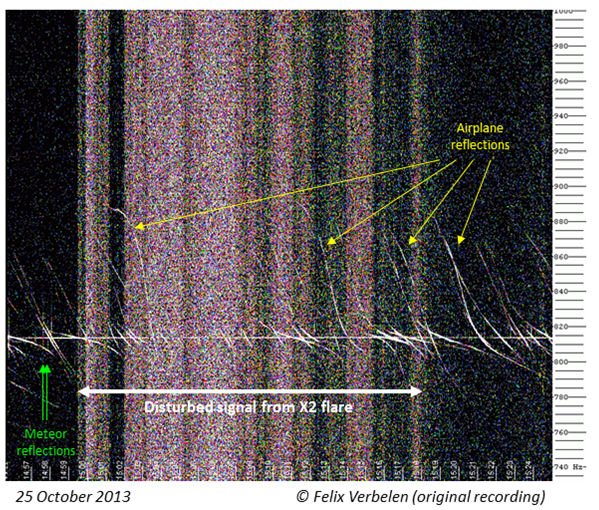
Credits - Data and imagery were taken from SDO (http://sdo.gsfc.nasa.gov/data/), the GONG H-alpha Network (http://halpha.nso.edu/), PROBA2/SWAP (http://proba2.oma.be/ssa) and (J)Helioviewer (http://www.helioviewer.org/).
More info on the magnetic classification of sunspot groups can be found at NOAA/SWPC (http://www.spaceweather.com/glossary/magneticclasses.html ) and STCE (http://www.sidc.oma.be/educational/classification.php#magnetic ).
More info on BRAMS (Belgian RAdio Meteor Stations) at http://brams.aeronomie.be/pages/home
Solar flare activity fluctuated between low and very high during the week.
In order to view the activity of this week in more detail, we suggest to go to the following website from which all the daily (normal and difference) movies can be accessed: http://proba2.oma.be/ssa
This page also lists the recorded flaring events.
A weekly overview movie can be found here (SWAP week 187).
http://proba2.oma.be/swap/data/mpg/movies/WeeklyReportMovies/WR187_Oct21_Oct27/weekly_movie_2013_10_21.mp4
Details about some of this week's events, can be found further below.
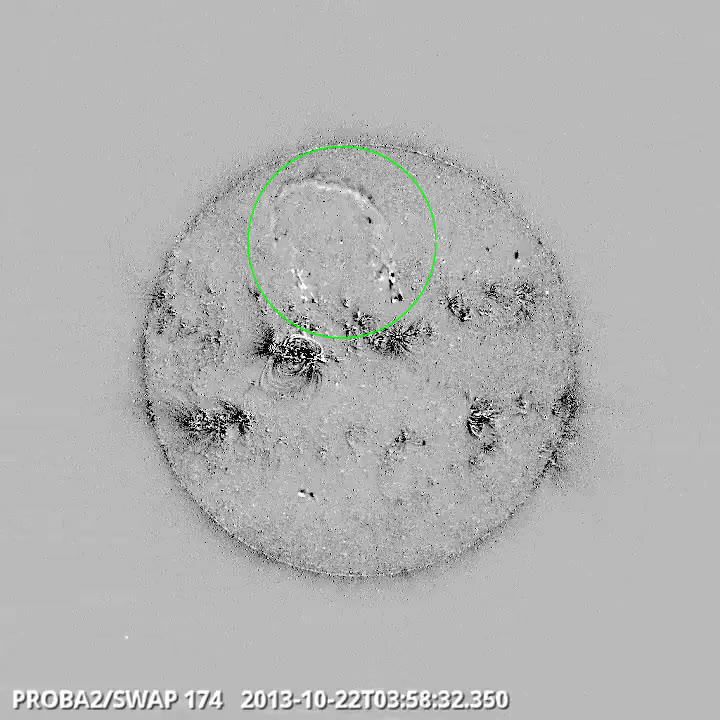
Eruption on the north half @ 03:58 - SWAP difference image
Find a movie of the event here (SWAP difference movie)
http://proba2.oma.be/swap/data/mpg/movies/WeeklyReportMovies/WR187_Oct21_Oct27/Events/20131022_Eruption_NorthEastQuad_0358_swap_diff.mp4
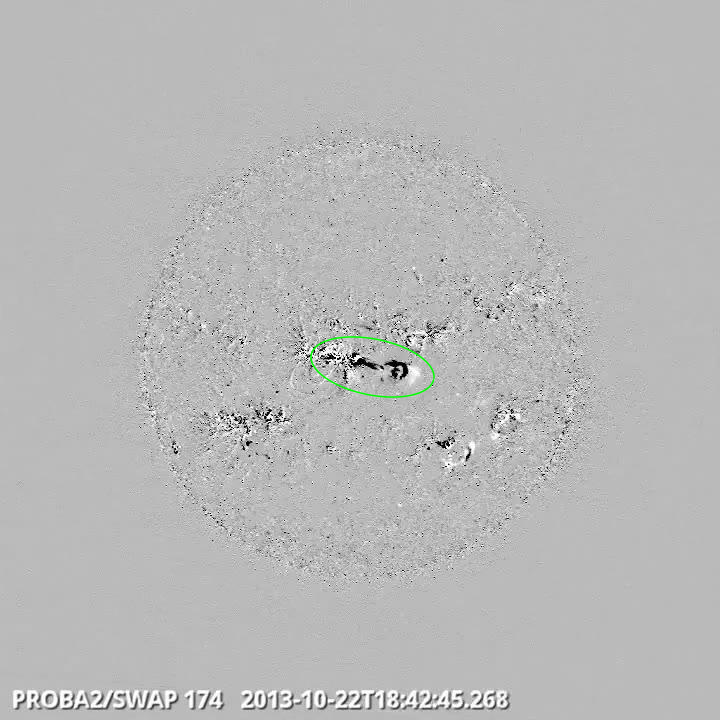
Surge on the centre @ 18:42 - SWAP difference image
Find a 24 hour movie of the event here (SWAP difference movie)
http://proba2.oma.be/swap/data/mpg/movies/WeeklyReportMovies/WR187_Oct21_Oct27/Events/20131022_Surge_centre_1200_24HourMovie_swap_diff.mp4
Find a 24 hour movie of the event here (SWAP movie)
http://proba2.oma.be/swap/data/mpg/movies/WeeklyReportMovies/WR187_Oct21_Oct27/Events/20131022_Surge_centre_1200_24HourMovie_swap_movie.mp4
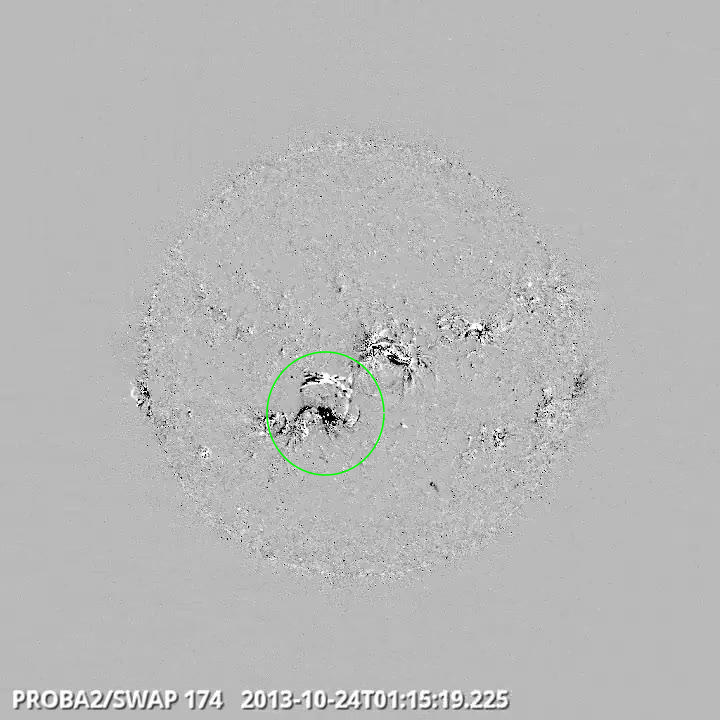
Failed filament eruption on south east quad @ 01:15 - SWAP difference image
Find a movie of the event here (SWAP difference movie)
http://proba2.oma.be/swap/data/mpg/movies/WeeklyReportMovies/WR187_Oct21_Oct27/Events/20131024_FailedEruption_SouthEastQuad_0115_swap_diff.mp4
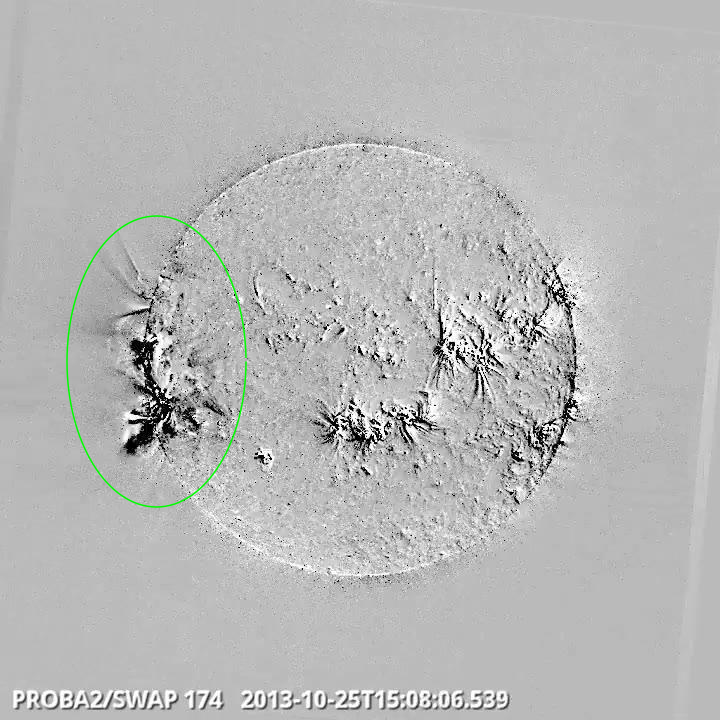
Eruption and eit-wave on east limb @ 15:08 - SWAP difference image
Find a movie of the event here (SWAP difference movie)
http://proba2.oma.be/swap/data/mpg/movies/WeeklyReportMovies/WR187_Oct21_Oct27/Events/20131025_EruptionEitWave_EastLimb_1508_swap_diff.mp4
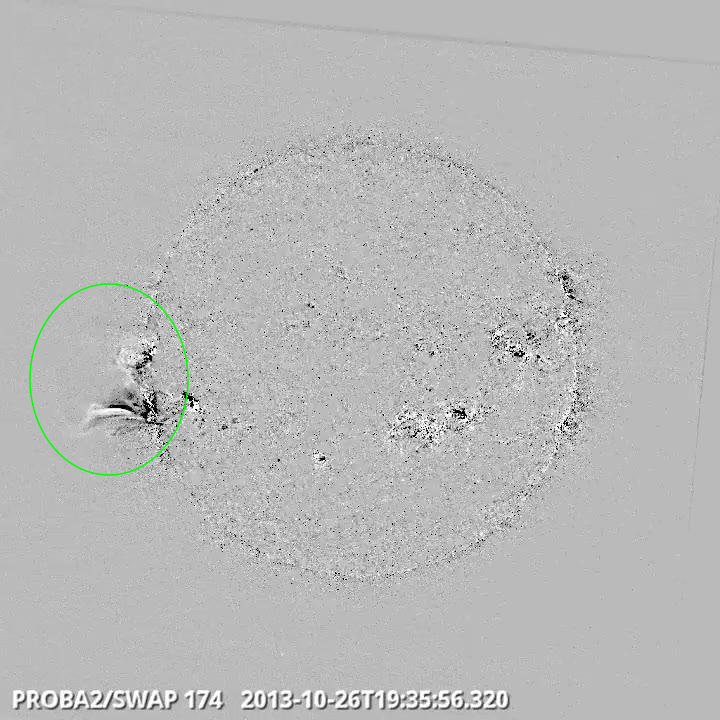
Eruption on east limb @ 19:35 - SWAP difference image
Find a movie of the event here (SWAP difference movie)
http://proba2.oma.be/swap/data/mpg/movies/WeeklyReportMovies/WR187_Oct21_Oct27/Events/20131026_Eruption_EastLimb_1935_swap_diff.mp4
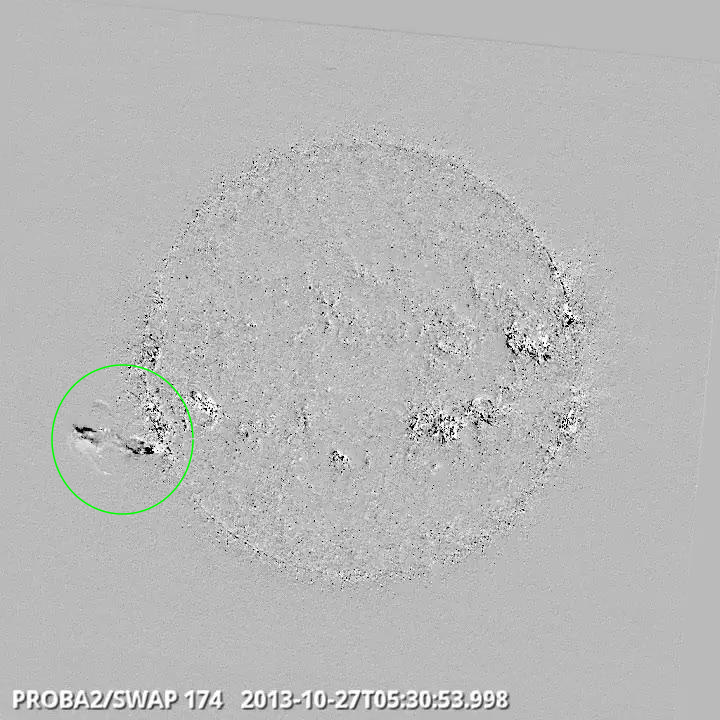
Failed filament eruption on the centre @ 05:30 - SWAP difference image
Find a movie of the event here (SWAP difference movie)
http://proba2.oma.be/swap/data/mpg/movies/WeeklyReportMovies/WR187_Oct21_Oct27/Events/20131027_FailedFillamentEruption_EastLimb_0530_swap_diff.mp4
Find a movie of the event here (SWAP movie)
http://proba2.oma.be/swap/data/mpg/movies/WeeklyReportMovies/WR187_Oct21_Oct27/Events/20131027_FailedFillamentEruption_EastLimb_0530_movie_diff.mp4
Solar activity was very high during the week of October 21 to 27, 2013 compared to the previous weeks. In total, two X flares, 20 M flares, and 70 C flares were observed. On October 22 and 23, the beta-gamma-delta region NOAA AR 11875 flared several times in the M-level. On October 24, both beta-gamma-delta AR 11875 and 11877 produced M flares. On October 25, new region AR 11882 near the East limb took over the leading role, releasing two X flares and several M flares, while AR 11875 and 11877 kept producing a steady flow of C flares with an occasional M flare. On October 26, new region AR 11884 near the East limb joined the M flaring club.
The X1.7 flare of October 25, peak at 08:01UT from source region AR 11882 was associated with a Type II radio burst with estimated shock speed of 1240 km/s as observed by the San Vito solar observatory. A corresponding front sided partial halo CME was registered by LASCO C2 around 8:24UT on October 25, with a plane of sky speed of 739 km/s. The X2.1 flare peaking at 15:03 UT on October 25, also released by AR 11882, was associated with a radio Type II burst with an estimated shock speed of 2078 km/s at Sagamore Hill. A corresponding frontsided partial halo CME was registered by LASCO C2 around 15:12UT on October 25, with a plane of sky speed of 1247 km/s.
Below a snapshot from the CACTus (http://sidc.oma.be/cactus/catalog/LASCO/2_5_0/qkl/2013/10/latestCMEs.html) output. The coloured horizontal lines represent a CME and are chronologically stacked on each other. The length of a line denotes the span width of the CME, while the horizontal position indicates the position of the CME: left/south - west - north - right/east. The green and yellow halo CME's span the complete width.

ACE observed a small jump in the solar wind at 21:44UT on October 26, which was probably caused by the weak CME of 22:00 UT on October 22, associated to an M4.2 flare released by AR 11875. There were no geomagnetic effects.
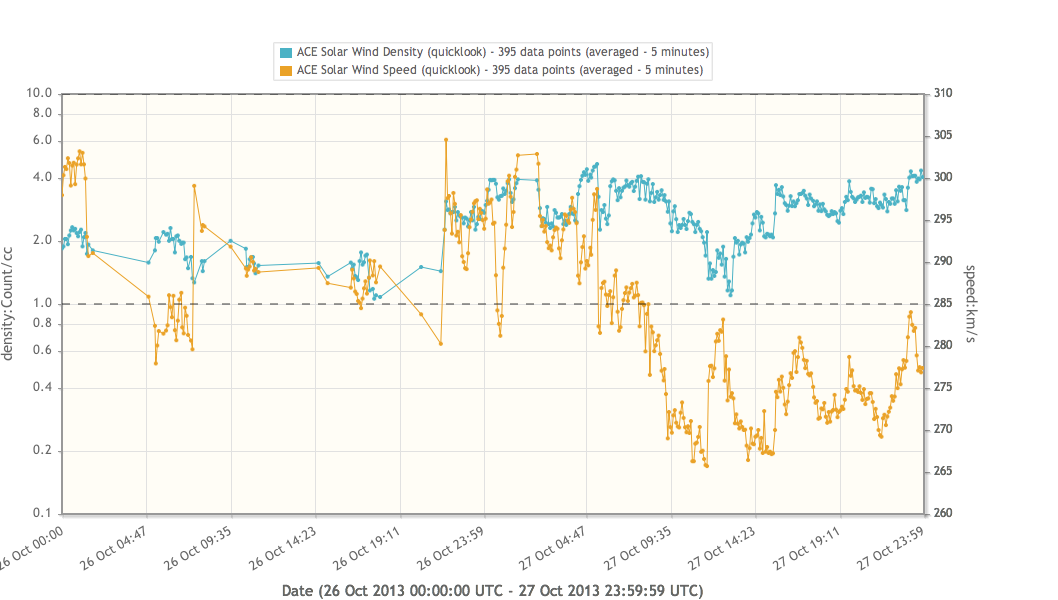
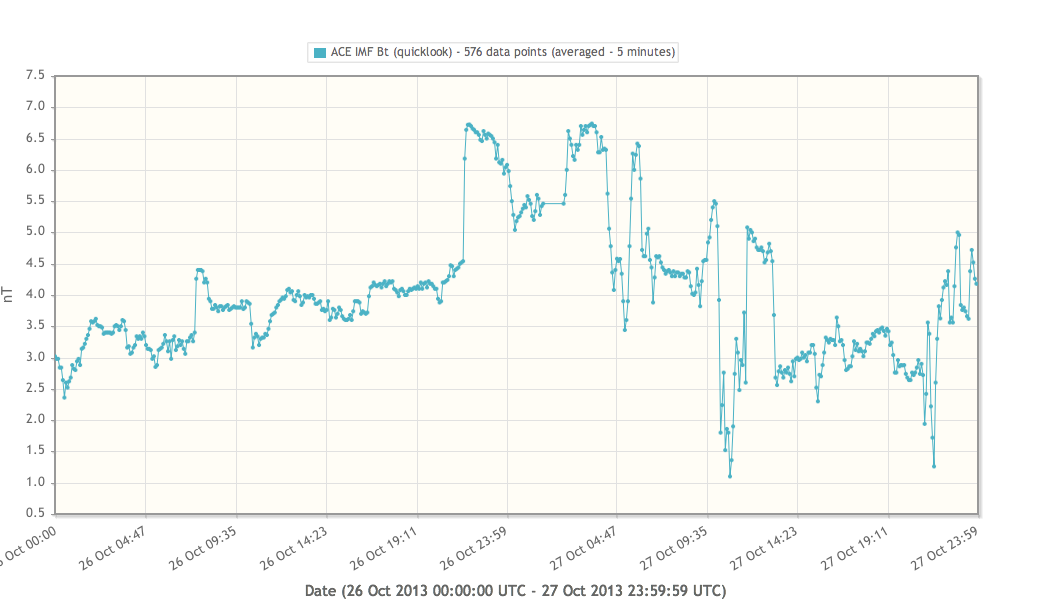

The two CME's mentioned above would arrive on October 29. There was no relevant geomagnetic impact.
| DAY | BEGIN | MAX | END | LOC | XRAY | OP | 10CM | TYPE | Cat | NOAA |
| 22 | 0014 | 0022 | 0028 | N6E17 | M1.0 | SF | 17 | 1875 | ||
| 22 | 1449 | 1520 | 1528 | N7E7 | M1.0 | SF | 17 | 1875 | ||
| 22 | 2115 | 2120 | 2122 | N4W1 | M4.2 | 1B | 220 | III/3V/2II/2 | 17 | 1875 |
| 23 | 2041 | 2053 | 2059 | M2.7 | 16 | 1875 | ||||
| 24 | 0021 | 0030 | 0035 | M9.3 | N | II/2I/1 1V/1 | 18 | 1877 | ||
| 23 | 2333 | 2343 | 2347 | M1.4 | F | 16 | 1875 | |||
| 23 | 2358 | 0008 | 0016 | M3.1 | 16 | 1875 | ||||
| 24 | 0959 | 1009 | 1017 | M2.5 | F | II/1 | 16 | 1875 | ||
| 24 | 1030 | 1033 | 1037 | M3.5 | 110 | V/1II/1 | 16 | 1875 | ||
| 25 | 0248 | 0302 | 0312 | M2.9 | II/1I/2 7V/1 | 23 | 1882 | |||
| 25 | 0753 | 0801 | 0809 | X1.7 | 610 | II/2I/2 1V/1 | 23 | 1882 | ||
| 25 | 0943 | 1012 | 1025 | M1.0 | F | II/1 | 23 | 1882 | ||
| 25 | 1451 | 1503 | 1512 | X2.1 | 370 | I/2 2V/2 | 23 | 1882 | ||
| 25 | 1702 | 1709 | 1716 | M1.3 | III/2 | 23 | 1882 | |||
| 25 | 1905 | 1921 | 1924 | S6E66 | M2.3 | SF | 23 | 1882 | ||
| 25 | 2054 | 2058 | 2113 | S7E64 | M1.9 | 1N | III/2 | 23 | 1882 | |
| 26 | 0559 | 0606 | 0620 | S9E61 | M2.3 | 1B | III/2 | 23 | 1882 | |
| 26 | 0917 | 0937 | 0948 | M1.5 | 67 | V/3II/2 | 23 | 1882 | ||
| 26 | 1048 | 1117 | 1134 | S5E58 | M1.8 | 1N | 380 | 23 | 1882 | |
| 26 | 1924 | 1927 | 1930 | S9E81 | M3.1 | SF | 1884 | |||
| 26 | 1949 | 1953 | 1958 | S7E53 | M1.0 | SF | 23 | 1882 | ||
| 27 | 1236 | 1248 | 1252 | N6W63 | M3.5 | 1F | III/1 | 16 | 1875 |
| LOC: approximate heliographic location | TYPE: radio burst type |
| XRAY: X-ray flare class | Cat: Catania sunspot group number |
| OP: optical flare class | NOAA: NOAA active region number |
| 10CM: peak 10 cm radio flux |

The figure shows the time evolution of the Vertical Total Electron Content (VTEC) (in red) during the last week at three locations:
a) in the northern part of Europe(N61°, 5°E)
b) above Brussels(N50.5°, 4.5°E)
c) in the southern part of Europe(N36°, 5°E)
This figure also shows (in grey) the normal ionospheric behaviour expected based on the median VTEC from the 15 previous days.
The VTEC is expressed in TECu (with TECu=10^16 electrons per square meter) and is directly related to the signal propagation delay due to the ionosphere (in figure: delay on GPS L1 frequency).
The Sun's radiation ionizes the Earth's upper atmosphere, the ionosphere, located from about 60km to 1000km above the Earth's surface.The ionization process in the ionosphere produces ions and free electrons. These electrons perturb the propagation of the GNSS (Global Navigation Satellite System) signals by inducing a so-called ionospheric delay.
See http://stce.be/newsletter/GNSS_final.pdf for some more explanations ; for detailed information, see http://gnss.be/ionosphere_tutorial.php
Start : 2013-11-11 - End : 2013-11-22
Magnetic fields play an important role in many astrophysical
processes. But magnetic are difficult to detect and to model or
understand, since the fundamental equations describing the behavior
of magnetized plasmas are highly non-linear. Hence, magnetic fields
are often an inconvenient subject which is overlooked or simply
neglected. Such difficulty burdens the research on magnetic fields,
which has evolved to become a very technical subject, with many
small disconnected communities studying specific aspects and
details.
The school tries to amend the situation by providing a unifying
view of the subject. The students would have a chance to understand
the behavior of magnetic fields in all astrophysical contexts, from
cosmology to the Sun. From star-bursting regions to AGNs in
galaxies. The school will present a balanced yet complete review of
our knowledge. Extensions into the unknown are also important to
indicate present and future lines of research.
The Winter School will bring together in a relaxed working
atmosphere a number of the leading scientists in this field, PhD
students and recent postdocs. The conditions for a successful
interaction will be granted, including two special sessions for
those students that want to present their own work.
Website:
http://www.iac.es/winterschool/2013/
Start : 2013-11-12 - End : 2013-11-15
Since its launch in Sep-2006, more than 600 refereed papers have
been published based on Hinode observations, presenting many new
and important findings to the scientific community. However, due to
the unexpectedly low levels of solar activity, until now the focus
has mainly been on the more quiescent aspects of the solar cycle.
With the solar maximum expected this year, through cooperative
observations with SDO, IRIS, and ground based observatories, Hinode
observations should lead to our understanding of active Sun
phenomena, such as solar flares and CMEs, to be greatly improved.
Making Hinode-7 an excellent opportunity to discuss solar activity
in the current solar cycle and the related science through the use
Hinode data, as well as other solar/space weather data. It will
also be interesting to use this meeting to broaden our focus to
include the solar-stellar connection as a means to deepen our
understanding of solar activity.
Momentum is also gaining for Solar-C, which is being developed
as an international collaboration between Japan, US and Europe. To
further discuss this mission, the Solar-C science meeting will be
held on 11-Nov.
Website:
http://www.kwasan.kyoto-u.ac.jp/hinode-7/
Start : 2013-11-13 - End : 2013-11-13
Most space weather occurs due to the Sun's emissions which
can affect the Earth's space environment. Modern society is
ever more dependent upon ground-based & spaceborne technology
which can be vulnerable to space weather. Satellites, GPS, aviation
& the electric power industry are all at risk from this &
hence space weather is now included on the UK's National Risk
Register. It is important to have long-running, continuous
observations for forecasting, nowcasting & for research in
space weather. This public meeting, held during the peak of the 11
year solar cycle, addresses the deficiency in continuous, long-term
observations & how this might be overcome.
Website:
http://www.rmets.org/events/space-weather-importance-observations
Start : 2013-11-18 - End : 2013-11-22
This International CAWSES-II Symposium hosted by SCOSTEP
(Scientific Committee on Solar-Terrestrial Physics) will provide an
excellent opportunity to discuss the scientific accomplishments of
CAWSES-II and look forward to SCOSTEP's future programs at a moment
toward the end of its five-year period. The symposium will cover
the six major themes of CAWSES-II tasks: 1) What are the solar
influences on the Earth's climate?, 2) How will geospace respond to
an altered climate?, 3) How does short-term solar variability
affect the geospace environment?, 4) What is the geospace response
to variable inputs from the lower atmosphere?, 5) Capacity
Building, 6) Informatics and eScience. The main functions of
CAWSES-II are to help coordinate international activities in
observations, modeling, and applications crucial to achieving this
understanding, to involve scientists in both developed and
developing countries, and to provide educational opportunities for
students of all levels. The symposium offers keynotes/lectures that
will be interesting for all participants every morning and more
specific sessions of presentations in the afternoon. We welcome all
those who are involved and/or interested in CAWSES-II to Nagoya in
the autumn when we will have the pleasure of being surrounded by
beautiful colorful leaves of this season.
Website:
http://www.cawses.org/CAWSES/leaflet_CAWSES-II_120229.pdf
Start : 2013-11-18 - End : 2013-11-22
The 10th Edition of the European Space Weather
Week will take place on 18-22nd
November 2013 in Belgium. The venue will be confirmed early next
year, but mark your calendars now for the 10th Anniversary of this
growing European event.
The ESWW will again adopt the central aim of bringing together
the diverse groups in Europe working on different aspects of Space
Weather
. This includes but isn't
limited to the scientific community, the engineering community,
applications developers, service providers and service end users.
The meeting organisation will again be coordinated by the Belgian
Solar-Terrestrial Centre of Excellence (STCE), ESA
and the Space Weather
Working Team. The local
organisation will be done by the STCE.
Website:
http://www.stce.be/esww10/
Start : 2013-11-26 - End : 2013-11-28
The 1st SPRING (Solar Physics Research Integrated Network Group)
workshop is being held from November 26 - 28, 2013 at the scenic
Brugger's Hotel Park by Titisee hosted by the Kiepenheuer-Institut
für Sonnenphysik in Freiburg, Germany.
The purpose of the workshop is to work on the scientific
requirements for a new ground-based network of telescopes for
full-disk synoptic observations of the Sun.
The desire for such a new network is motivated by new scientific
research directions in solar physics, the requirement of real-time
context data for high-resolution solar telescopes, and the need of
continuous, long-term, consistent, and reliable solar data as
foundation for space weather prediction.
Website:
http://www3.kis.uni-freiburg.de/~mroth/spring.html
Start : 2013-12-13 - End : 2013-12-13
The inclusion of space weather in the National Risk Assessment
in 2012 means that there is now an urgent need for dialogue between
those doing the science of space weather and those using the data
to forecast, understand and mitigate the risks.
Since the Sun is currently at the peak of its cycle - a time
when space weather events become more frequent - we have a timely
opportunity to study how a range of solar activity ultimately lead
to magnetospheric, ionospheric and ground level disturbances.
The goal of this meeting is to bring together those working
across the broad range of space weather activities in the UK to
discuss the current status of observations and recent new advances
in the theories and models of the phenomena of space weather.
Website:
http://www.mssl.ucl.ac.uk/~lmg/spaceweather/Overview.html
Start : 2014-02-10 - End : 2014-02-11
The International Space Weather Initiative (ISWI), with the
support of the United Nations Committee for the Peaceful Uses of
Outer Space, has been very active in promoting the installation of
new ground-based instrumentation in non-traditional locations. In
particular, there has been substantial progress in the observation
of the equatorial ionosphere, solar transients, and energetic
particles from space. In the coming decade these observations will
become available in real time and will be an important new data
source for the forecasting of space weather events. New instruments
are either in the process of deployment, or planned over the next
decade. Similarly, the International Living with a Star (ILWS)
program has been very active coordinating the plans of the world's
space agencies in the planning of new space missions, and in the
development of space weather modeling and forecasting.
Website:
http://newserver.stil.bas.bg/ISWI/Meetings/Cevents.html#item12
Start : 2014-03-16 - End : 2014-03-22
The meeting brings together scientists working in solar physics,
space physics, plasma physics, and astrophysics, in theory,
simulations, and experiment. The objective is to report and discuss
recent progress in our understanding of the fundamental processes
in solar, space, and astrophysical plasmas, in view of heliospheric
in-situ and remote sensing measurements (Van Allen Probe, Themis,
Cluster, Stereo, SDO, Messenger, Cassini, Venus-Express) and remote
sensing astrophysical observations (Chandra, XMM-Newton, Swift and
Fermi Gamma-ray Telescope).
Website:
http://physics.bgu.ac.il/~gedalin/Isradynamics2014/
Start : 2014-06-23 - End : 2014-06-27
The meeting in honour of Prof. Zdenek Svestka will cover issues
of the physics of solar and stellar flares.
Website:
http://solarflares2014.cz/
Start : 2014-08-02 - End : 2014-08-10
The 40th COSPAR Scientific Assembly will be held in Moscow,
Russia from 2 - 10 August 2014. This Assembly is open to all bona
fide scientists.
Website:
http://www.cospar-assembly.org/
Start : 2014-08-31 - End : 2014-09-05
Low-frequency waves (ULF, ELF and VLF) in space plasmas have
been studied for many decades. In our solar system, such waves
occur in the magnetospheres of planets and in the solar wind; more
recently they have also been confirmed on the Sun. In spite of the
great differences in the plasma properties of these regions, the
overarching schemes are wave generation, wave propagation, and wave
dissipation, which are three fundamental aspects of any kind of
waves. A fourth aspect of these waves is their application, either
with direct benefit to humans or for scientific pursuit. Therefore,
this Chapman conference will provide a forum in which various wave
communities can come together and discuss recent achievements of
observational, theoretical, and modeling studies.
Website:
http://chapman.agu.org/spaceplasmas/
Start : 2014-09-08 - End : 2014-09-12
The European Solar Physics Meetings aim to highlight all aspects
of modern solar physics, including observation and theory that span
from the interior of the Sun out into the wider heliosphere. These
meetings provide a broad, yet stimulating, environment for European
and international scientists to share their research in solar
physics.
The meeting will mostly comprise of contributed talks and poster
presentations, with several invited review talks (typically one per
session). Posters will be on display for the whole meeting in close
proximity to the lecture theatre. Refreshments will be served in
the poster viewing area during two dedicated coffee/poster breaks
on each full day.
Website: http://www.espm14.ie/
Start : 2015-06-22 - End : 2015-06-26
The Fourteenth International Solar Wind Conference will be held
for the first time ever in China, from 22 to 26 June 2015, at
Weihai in the Shandong province. It will be jointly organized by
the School of Earth and Space Sciences of Peking University and the
newly-established Institute of Space Sciences of Shandong
University. The meeting will take place in the Space Science
Building of Shandong University, a venue located within walking
distance to the beautiful Weihai International Bathing Beach, one
of the most popular scenic areas of northern China.
The conference will cover all aspects of solar wind physics,
with invited reviews and contributed papers that examine the
current research and outline the future research in all the
relevant solar wind fields.
Website: not available yet